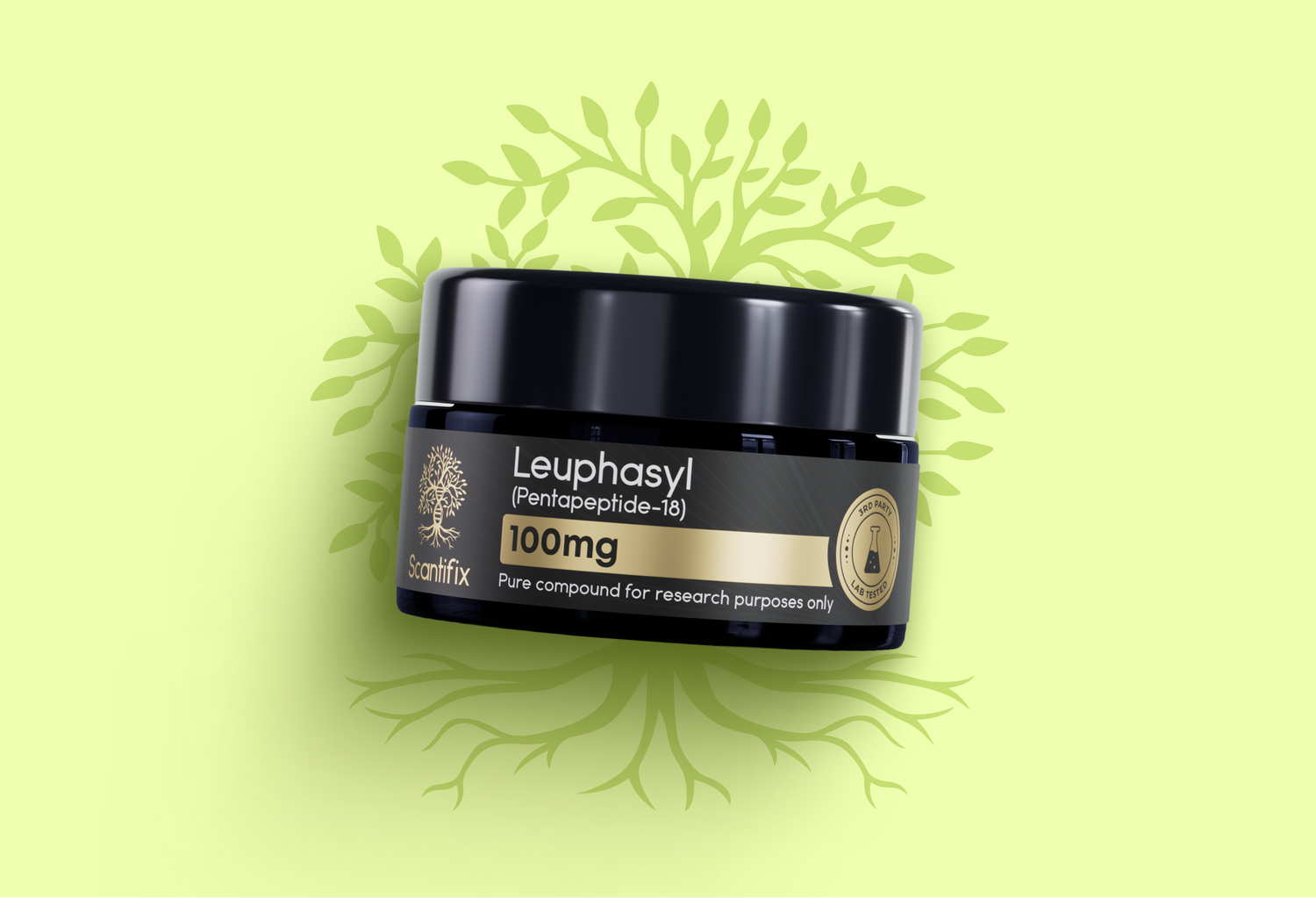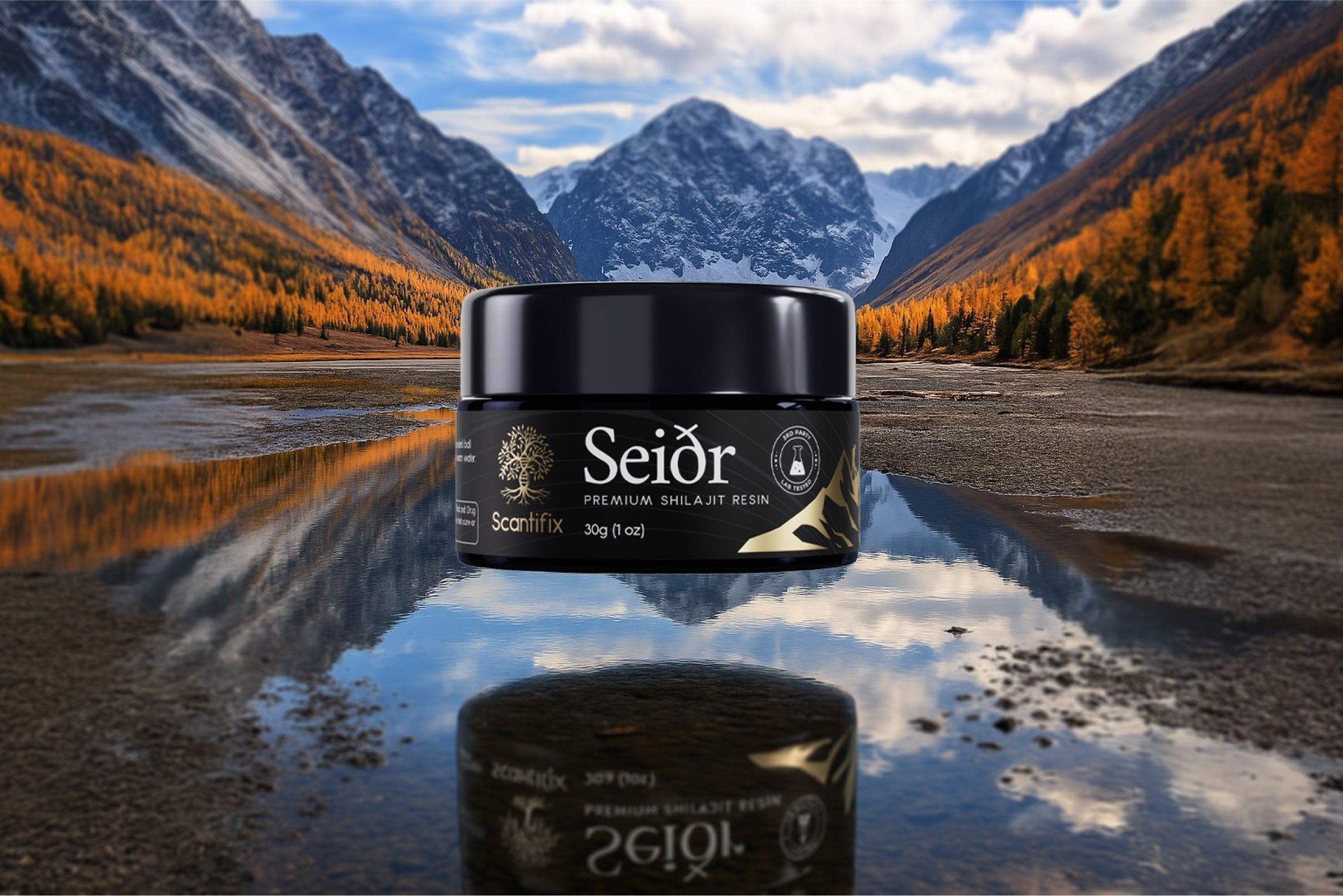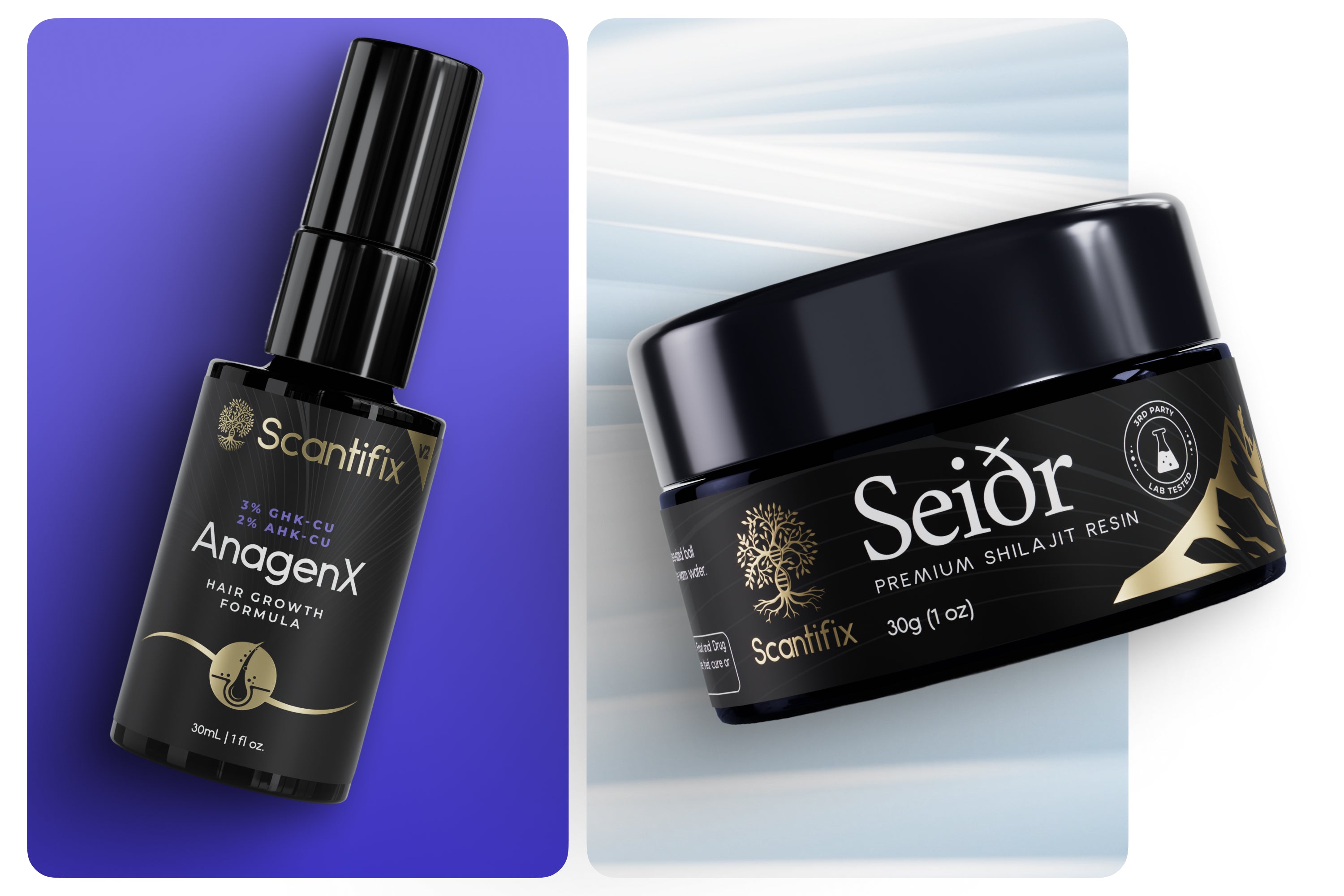Wrinkles are part of the inevitable march of time, but modern skincare science is uncovering fascinating solutions to help soften their impact. Among these, without a doubt, are wrinkle-smoothing peptides. Well-established examples include GHK-Cu, known for its skin-regenerative and collagen-boosting potential, Snap 8, recognized for its Botox-like effects, and Serpen-Syl, which mimics snake venom in its muscle-relaxing properties. Each has its strengths, and together, they’ve carved out an important role in the anti-aging skincare arsenal.
While these peptides have already earned widespread recognition, a lesser-known contender is slowly but surely claiming its seat at the mainstream table: Leuphasyl.
So let’s give it the spotlight it deserves. We believe it’s high time we talk about this quietly effective, expression-friendly alternative.
What is Leuphasyl
Leuphasyl, also known scientifically as Pentapeptide-18, is a small-chain peptide specifically designed to reduce the appearance of dynamic wrinkles. Structurally, it is composed of five amino acids with a modified enkephalin sequence, meaning it mimics natural processes in the body by binding to specific skin cell receptors. Unlike some peptides that are isolated from biological sources, Leuphasyl was bioengineered for one purpose: to relax facial tension. It was formulated with the elegance of molecular design, precise enough to target neurotransmitter release and gentle enough to avoid over-paralysis.
Its molecular formula, C34H60N14O12S, may look intimidating, but what it represents is a controlled, purposeful sequence of biochemistry. It fits into the broader picture of neurotransmitter-inhibiting peptides, a fascinating frontier in dermatological science.
How does Leuphasyl work
Leuphasyl works its magic by calming the muscle movements that lead to expression lines, like forehead creases and crow’s feet. It does this by mimicking enkephalins, your body’s natural “chill out” chemicals. Basically, it sends a message through the enkephalin receptor on your facial muscles, telling them to ease up by blocking acetylcholine - the signal that triggers contraction.
But imagine it like a dimmer switch, not an off button. Leuphasyl doesn’t paralyze your muscles like Botox or even go as hard as Snap-8. Instead, it gently reminds them to relax. That subtle approach makes it a great option for everyday use, especially if you want to smooth lines without losing your natural expressions.
Leuphasyl peptide benefits
The biggest benefit of Leuphasyl is its already-mentioned ability to reduce expression lines without freezing your face. Users often report smoother skin with more subtle muscle relaxation compared to stronger neuro-inhibiting peptides. This allows for a natural look, something we believe the beauty industry is slowly shifting toward.
Leuphasyl is also well-tolerated and suitable for sensitive skin, thanks to its targeted mechanism. It can be used around delicate areas like the eyes and mouth, where wrinkle formation is most pronounced. Its gentle, accumulative effect means visible improvements can be observed in weeks rather than months.
Leuphasyl products
Like most peptides, Leuphasyl started in clinical studies before finding its way into cosmetic formulations. Today, you can find it in a variety of delivery systems:
Powder Leuphasyl Peptide
Raw powder Leuphasyl peptide is the purest, most unformulated, and most potent form of this active ingredient. It offers flexibility for cosmetic chemists and skincare DIYers alike, allowing them to create customized serums and creams by combining it with a preferred water-based carrier and other active ingredients. If you understand your skin and enjoy crafting personalized skincare, this peptide powder offers a playground of potential.
Leuphasyl Serum
Serums are the most popular delivery method for Leuphasyl. These water-based solutions penetrate deeply and allow for quick absorption. Most effective formulations pair Leuphasyl with Argireline, a peptide that complements its muscle-relaxing action. The result? A dynamic duo that softens lines while preserving mobility.
Leuphasyl Cream
Creams containing Leuphasyl often cater to mature skin types. They blend hydration with peptide action, offering both barrier support and anti-wrinkle effects. These are ideal for nighttime use, when the skin is most receptive to repair.
Leuphasyl in DIY skincare
DIY skincare is booming, and peptides are at the heart of it. For those dabbling in home formulation, Leuphasyl is typically used at a concentration of 0.5% to 1% and pairs well with hyaluronic acid and other peptides like GHK Cu (for skin regeneration and collagen stimulation), SNAP-8 (for stronger wrinkle relaxation), and the previously mentioned Argireline (a staple in expression-line formulas).
Best Leuphasyl
We’re sorry to say it, but not all peptides are created equal. When it comes to Leuphasyl, purity and testing matter. No exceptions. Avoid the temptation to buy cheap Leuphasyl from unverified sellers. To ensure you’re getting the real deal, high-quality peptides should be at least 99% pure, third-party tested, and sourced from a reputable supplier. Impurities can reduce effectiveness or irritate your skin, so always look for products that list exact percentages and provide certificates of analysis (COAs) - like those you'll find in our store.
Buy Leuphasyl
Leuphasyl vs. Other wrinkle-smoothing peptides
Now, let’s take a look at how Leuphasyl compares to some of the most well-known wrinkle smoothers.
Leuphasyl vs. GHK-Cu
GHK-Cu is a copper peptide known for regenerative and healing properties. While Leuphasyl focuses on muscle relaxation, GHK-Cu supports collagen production and tissue repair. They serve different functions but can complement each other in a well-rounded routine.
Leuphasyl vs. Snap-8
Snap-8 is often called "Botox in a bottle" for its strong muscle inhibition. However, some users find it too intense, especially around the eyes. Leuphasyl offers a subtler effect, which is preferred by those seeking expression retention.
Leuphasyl vs. Serpen-Syl
Serpen-Syl (Dipeptide Diaminobutyroyl Benzylamide Diacetate) mimics snake venom and works by blocking muscle receptors. It's potent but can cause a noticeable stillness in facial expression. Leuphasyl provides a more natural, nuanced alternative.
Leuphasyl vs. Argireline
Argireline, or Acetyl Hexapeptide-8, is the most popular neuropeptide in skincare. It acts at the start of the muscle contraction cascade, whereas Leuphasyl acts at the receptor level. Together, they tackle the wrinkle formation process from two angles. This synergy is why many advanced formulas include both.
What the Data Shows
Alright, time to look under the hood, because numbers don’t lie, and the science behind Leuphasyl is pretty exciting:
-
A 2014 clinical study evaluated the efficacy of a 2% Leuphasyl cream applied twice daily over 60 days. The results demonstrated a 34.7% reduction in forehead wrinkle depth and a 28.4% reduction around the eyes.
-
A 2005 manufacturer-conducted trial assessed the effects of a 5% Leuphasyl cream applied twice daily for 28 days. The study reported an 11.64% reduction in wrinkle depth.
-
The same 2005 trial also examined a combination of 5% Leuphasyl and 5% Argireline applied over 28 days, resulting in an average wrinkle depth reduction of 24.62%, with maximum reductions observed up to 46.53%, indicating a synergistic effect between the two peptides.
Final thoughts
In the vast and sometimes overwhelming world of anti-aging skincare, Leuphasyl offers a balanced and intelligent approach. It’s ideal for those just starting out with peptides and for anyone who furrows their brows while concentrating, or even while reading this article. Its science-backed benefits, subtle results, and expression-friendly mechanism make it an exciting part of the modern skincare toolkit.
If you’re looking to buy high-quality, 99.58% pure topical Leuphasyl, head over to our store. And the same goes for GHK-Cu, Snap-8, and other cosmetic peptides. With transparent third-party testing, expert formulation support, and fast shipping, Scantifix makes your journey into peptides easy, safe, and rewarding.

|
 |
 |
References
1. Schagen, S. K., Zampeli, V. A., Makrantonaki, E., & Zouboulis, C. C. (2009). Discovering the link between nutrition and skin aging. Dermato-Endocrinology, 4(3), 298–307. https://doi.org/10.4161/derm.22876
2. Di Lorenzo, R. (2023). Biomimetic peptides in dermatology interfering with neurotransmission. Cosmetics, 10(4), 118. https://doi.org/10.3390/cosmetics10040118
3. Blanes-Mira, C., Clemente, J., Jodas, G., Gil, A., Fernández-Ballester, G., Ponsati, B., Gutierrez, L. M., & Pérez-Payá, E. (2002). A synthetic hexapeptide (Argireline) with antiwrinkle activity. International Journal of Cosmetic Science, 24(5), 303–310. https://doi.org/10.1046/j.1467-2494.2002.00155.x
4. Lipotec. (2005). LEUPHASYL®: A New Pentapeptide for Expression Wrinkles. [PDF]. Retrieved from https://daltosur.com/media/documents/leuphasyl-peptide-solutiontds052022.pdf
5. Zhang, L., & Falla, T. J. (2009). Cosmeceuticals and peptides. Clinics in Dermatology, 27(5), 485–494. https://doi.org/10.1016/j.clindermatol.2009.05.013
6. Dragomirescu, A. O., Andoni, M., Ionescu, D., & Andrei, F. (2014). The efficiency and safety of Leuphasyl—A Botox-like peptide. Cosmetics, 1(2), 75–81. https://doi.org/10.3390/cosmetics1020075





Leave a comment
All comments are moderated before being published.
This site is protected by hCaptcha and the hCaptcha Privacy Policy and Terms of Service apply.